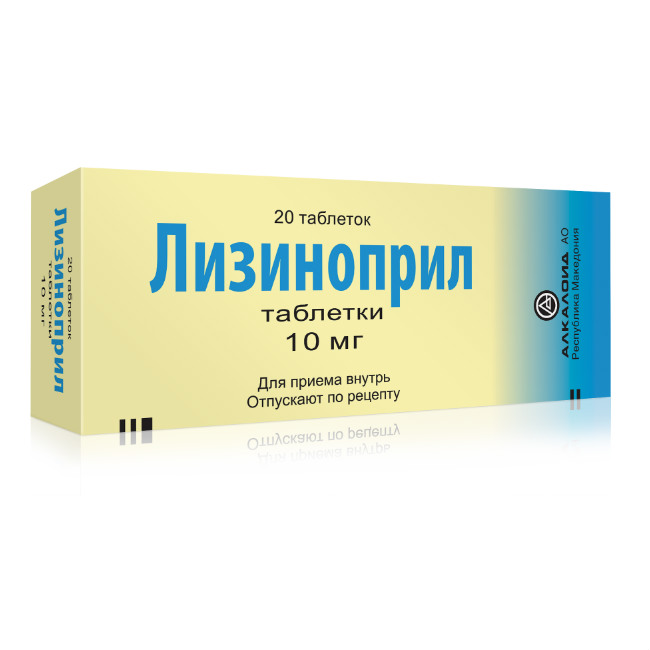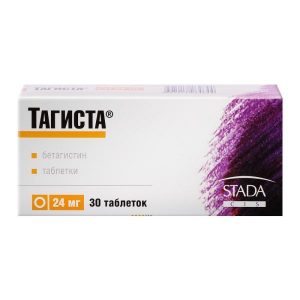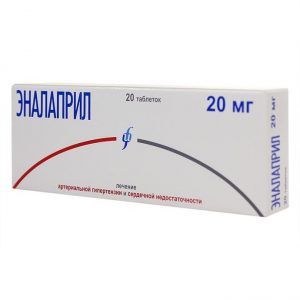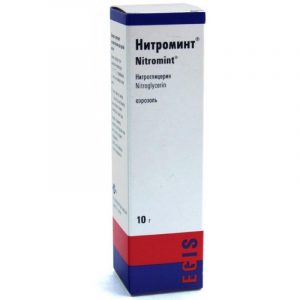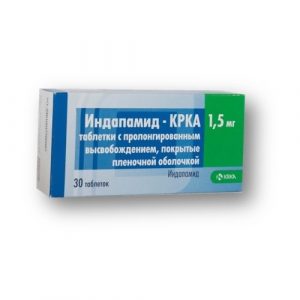Description
Pharmacological action
ACE inhibitor, reduces the formation of angiotensin II from angiotensin I. A decrease in the content of angiotensin II leads to a direct decrease in the release of aldosterone. Reduces the degradation of bradykinin and increases the synthesis of prostaglandins.
Reduces total peripheral vascular resistance, blood pressure (BP), preload, pressure in the pulmonary capillaries, causes an increase in minute blood volume and increased myocardial tolerance to stress in patients with chronic heart failure. Expands arteries to a greater extent than veins.
Some effects are attributed to effects on tissue renin-angiotensin systems. With prolonged use, hypertrophy of the myocardium and walls of the arteries of the resistive type decreases. Improves blood supply to the ischemic myocardium.
ACE inhibitors lengthen life expectancy in patients with chronic heart failure, slow the progression of left ventricular dysfunction in patients after myocardial infarction without clinical manifestations of heart failure.
The antihypertensive effect begins after approximately 6 hours and lasts for 24 hours. The duration of the effect also depends on the dose. The onset of action is after 1 hour. The maximum effect is determined after 6-7 hours. With arterial hypertension, the effect is observed in the first days after the start of treatment, a stable effect develops after 1-2 months. With a sharp withdrawal of the drug, no marked increase in blood pressure was observed.
In addition to lowering blood pressure, lisinopril reduces albuminuria. In patients with hyperglycemia, it helps normalize the function of damaged glomerular endothelium.
Lisinopril does not affect the blood glucose concentration in patients with diabetes mellitus and does not increase the incidence of hypoglycemia.
Indications
Arterial hypertension (in monotherapy or in combination with other antihypertensive agents)
Chronic heart failure (as part of combination therapy for the treatment of patients digitalis and / or diuretics)
Early treatment of acute myocardial infarction (in the first 24 hours with stable hemodynamics to maintain these parameters and prevent left ventricular dysfunction and heart failure)
Diabetic nephropathy (decrease in albuminuria in insulin-dependent patients with normal A and D patients with arterial hypertension).
Special instructions
Symptomatic hypotension
Most often, a marked decrease in blood pressure occurs with a decrease in fluid volume caused by diuretic therapy, a decrease in the amount of salt in food, dialysis, diarrhea, or vomiting. In patients with chronic heart failure with simultaneous renal failure or without it, a marked decrease in blood pressure is possible. It is more often detected in patients with severe chronic heart failure, as a result of the use of large doses of diuretics, hyponatremia, or impaired renal function. In such patients, treatment with lisinopril should be started under the strict supervision of a physician (with caution, select a dose of the drug and diuretics).
Similar rules should be followed when prescribing patients with coronary heart disease, cerebrovascular insufficiency, in which a sharp decrease in blood pressure can lead to myocardial infarction or stroke.
Transient hypotensive reaction is not a contraindication for taking the next dose of the drug.
When using lisinopril in some patients with chronic heart failure, but with normal or low blood pressure, a decrease in blood pressure may occur, which is usually not the reason for stopping treatment.
Before starting treatment with lisinopril, if possible, normalize the concentration of sodium and / or replenish the lost volume of fluid, carefully monitor the effect of the initial dose of lisinopril on the patient.
In case of stenosis of the renal artery (especially with bilateral stenosis, or in the presence of stenosis of an artery of a single kidney), as well as in case of circulatory failure due to lack of sodium and / or fluid, the use of lisinopril can lead to impaired renal function, acute renal failure, which usually turns out to be irreversible after discontinuation of the drug.
In acute myocardial infarction
The use of standard therapy (thrombolytics, acetylsalicylic acid, beta-blockers) is indicated. Lisinopril can be used in conjunction with intravenous administration or with the use of therapeutic transdermal systems of nitroglycerin.
Surgical intervention / general anesthesia
With extensive surgical interventions, as well as with the use of other drugs that cause a decrease in blood pressure, lisinopril, blocking the formation of angiotensin II, can cause a pronounced unpredictable decrease in blood pressure.
In elderly patients, the same dose leads to a higher concentration of the drug in the blood, therefore, special care is required in determining the dose.
Since the potential risk of agranulocytosis cannot be ruled out, periodic monitoring of the blood picture is required. When using the drug in dialysis with a polyacryl-nitrile membrane, anaphylactic shock can occur, therefore, it is recommended that either a different type of membrane for dialysis, or the appointment of other antihypertensive agents.
Influence on the ability to drive vehicles and mechanisms
There is no data on the effect of lisinopril on the ability to drive vehicles and mechanisms used in therapeutic doses, however, it should be borne in mind that dizziness may occur, therefore caution should be exercised.
Composition
One tablet contains:
active substance:
lisinopril dihydrate – 10.9 mg, which corresponds to 10 mg of lisinopril
excipients:
lactose monohydrate (milk sugar) – 20.0 mg,
cellulose microc mg,
pregelatinized starch (starch 1500) – 22.0 mg,
silicon dioxide colloidal dioxide (aerosil) – 0.3 mg,
talcum powder – 2.0 mg,
magnesium stearate – 1.0 mg.
Dosage and administration
Inside, regardless of food intake. With arterial hypertension, patients not receiving other antihypertensive drugs are prescribed 5 mg once a day. In the absence of effect, the dose is increased every 2-3 days by 5 mg to an average therapeutic dose of 20-40 mg / day (increasing the dose above 40 mg / day usually does not lead to a further decrease in blood pressure). The usual daily maintenance dose is 20 mg. The maximum daily dose is 40 mg.
The full effect usually develops after 2-4 weeks from the start of treatment, which should be considered when increasing the dose. With insufficient clinical effect, it is possible to combine the drug with other antihypertensive drugs.
If the patient received preliminary treatment with diuretics, then the administration of such drugs must be stopped 2-3 days before the start of lisinopril. If this is not feasible, then the initial dose of lisinopril should not exceed 5 mg per day. In this case, after taking the first dose, medical monitoring is recommended for several hours (the maximum effect is achieved after about 6 hours), since a marked decrease in blood pressure may occur.
In case of renovascular hypertension or other conditions with increased activity of the renin-angiotensin-aldosterone system, it is also advisable to prescribe a low initial dose – 2, 5-5 mg per day, under enhanced medical supervision (control of blood pressure, renal function, serum potassium concentration). A maintenance dose, continuing strict medical supervision, should be determined depending on the dynamics of blood pressure.
In case of renal failure, due to the fact that lisinopril is excreted through the kidneys, the initial dose should be determined depending on the creatinine clearance, then, in accordance with the reaction, a maintenance dose should be established under conditions of frequent monitoring of renal function, potassium, sodium in blood serum.
Creatinine clearance
Initial dose
ml / min
mg / day
30-70
5-10
10-30
2.5-5
less than 10
2.5
(including patients treated with hemodialysis)
With persistent arterial hypertension, long-term maintenance therapy of 10-15 mg / day is indicated.
In chronic heart failure – start with 2.5 mg once a day, followed by a dose increase of 2.5 mg after 3-5 days to the usual, supporting daily dose of 5-20 mg. The dose should not exceed 20 mg per day.
In elderly people, a more pronounced long-term hypotensive effect is often observed, which is associated with a decrease in the rate of lysinopril excretion (it is recommended to start treatment with 2.5 mg / day).
Acute myocardial infarction (as part of combination therapy)
On the first day, 5 mg orally, then 5 mg every other day, 10 mg after two days, and then 10 mg once a day. In patients with acute myocardial infarction, the drug should be used for at least 6 weeks.
At the beginning of treatment or during the first 3 days after acute myocardial infarction in patients with low systolic blood pressure (120 mmHg or lower), a lower dose of 2.5 mg should be prescribed. In the event of a decrease in blood pressure (systolic blood pressure below or equal to 100 mm Hg), a daily dose of 5 mg can, if necessary, be temporarily reduced to 2.5 mg. In the case of a prolonged marked decrease in blood pressure (systolic blood pressure below 90 mm Hg for more than 1 hour), treatment with lisinopril must be discontinued.
Diabetic nephropathy
In patients with non-insulin-dependent diabetes mellitus, 10 mg of lisinopril is used once a day. The dose can, if necessary, be increased to 20 mg once a day in order to achieve diastolic blood pressure values below 75 mm Hg. in a sitting position. In patients with insulin-dependent diabetes mellitus, the dosage is the same in order to achieve diastolic blood pressure values below 90 mm Hg in a sitting position.
Side effects
The most common side effects: dizziness, headache (in 5-6% of patients), weakness, diarrhea, dry cough (3%), nausea, vomiting, orthostatic hypotension, skin rash, chest pain (1 -3%).
Other side effects (frequency <1%):
Immune system: (0.1%) angioedema (face, lips, tongue, larynx or epiglottis, upper and lower extremities).
From the cardiovascular system: a marked decrease in blood pressure, orthostatic hypotension, impaired renal function, heart rhythm disturbance, heart palpitations.
From the central nervous system: increased fatigue, drowsiness, convulsive twitching of the muscles of the limbs and lips.
From the hemopoietic system: possible leukopenia, neutropenia, agranulocytosis, thrombocytopenia, with prolonged treatment – a slight decrease in the concentration of hemoglobin and hematocrit, erythrocytopenia.
Laboratory indicators: hyperkalemia, azotemia, hyperuricemia, hyperbilirubinemia, increased activity of ² Ñliver ² Ñ enzymes, especially if there is a history of kidney disease, diabetes mellitus, and renovascular hypertension.
Rarely encountered side effects (less than 1%):
From the cardiovascular system: palpitations tachycardia myocardial infarction cerebrovascular stroke in patients with an increased risk of the disease, due to a marked decrease in blood pressure.
From the digestive tract: dry mouth, anorexia, dyspepsia, taste changes, abdominal pain, pancreatitis, hepatocellular or cholestatic jaundice, hepatitis.
From the skin: urticaria, sweating, pruritus, alopecia.
From the urinary system: impaired renal function, oliguria, anuria, acute renal failure, uremia, proteinuria.
On the part of the immune system: a syndrome that includes an acceleration of the erythrocyte sedimentation rate (ESR), arthralgia and the appearance of antinuclear antibodies.
From the central nervous system: asthenic syndrome, mood lability, confusion, decreased potency.
Other: myalgia, fever, impaired fetal development.
Overdose
Symptoms (occur when taking a single dose of 50 mg or higher): marked decrease in blood pressure, dry mouth, drowsiness, urinary retention, constipation, anxiety, increased irritability.
Treatment: symptomatic therapy, intravenous fluids, control of blood pressure, electrolyte balance and normalization of the latter.
Lisinopril can be removed from the body via hemodialysis.
Storage conditions
Store at a temperature not exceeding 30 ° C.
Keep out of the reach of children.
Expiration
3 years.
Deystvuyuschee substances
lisinopril
Terms and conditions
prescription
dosage form
tablets
